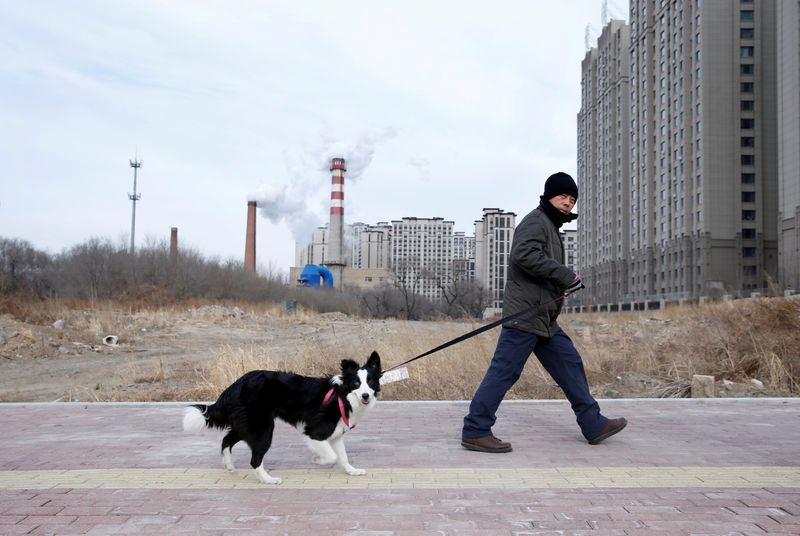BEIJING (Reuters) – China may struggle to meet its climate pledges this year as it turns to heavy industry and carbon-intensive projects to shore up its coronavirus-stricken economy, government researchers and analysts say.
China pledged to cut “carbon intensity” – the amount of CO2 emissions it produces per unit of GDP – by 40%-45% from 2005-2020 as part of the global climate change pact it signed in Paris in 2015.
The world’s biggest greenhouse gas producing country had been on course to reach its target at the end of last year, prompting calls for Beijing to set more ambitious goals.
But experts say the economic damage done by the pandemic – especially to the less carbon-intensive service sector – has made the target far harder to meet.
“We had thought it wouldn’t be a problem for China to meet the carbon targets if previous efforts continued to be carried out,” said an expert at a think tank affiliated with China’s state planning agency, the National Development and Reform Commission (NDRC).
“But the coronavirus outbreak and the approaches to economic stimulus may bring uncertainties,” said the expert, who declined to be named as he is not authorised to talk to the media.
In its own five-year plan, China pledged to cut carbon intensity by 18% from 2015 to 2020, and energy intensity – the amount consumed per unit of economic growth – by 15%.
By last year, energy intensity had fallen 13.2% compared to 2015, according to Reuters calculations based on official data.
(GRAPHIC: China’s carbon intensity in 2016-2020 – https://fingfx.thomsonreuters.com/gfx/ce/jznpnerzmvl/carbon%20intensity.JPG)
China had also slashed carbon intensity by 18.4% compared with 2015 and by more than 45% compared with 2005, putting it on course to meet its own target as well as its Paris pledge.
(GRAPHIC: China’s energy intensity in 2016-2020 – https://fingfx.thomsonreuters.com/gfx/ce/dgkvlgoxjpb/energy%20intensity.JPG)
The coronavirus outbreak caused China’s carbon emissions to fall 25% in February, according to one estimate, and another study published this week said CO2 emissions from fossil fuel sources fell by as much as 17% a day worldwide in April.
But there are already signs China is turning to “dirty” industries and investments to kickstart its economy, which slowed for the first time in decades in the first quarter.
More heavy industrial output and infrastructure construction over the rest of the year, combined with a weakened service sector, will raise the amount of CO2 produced per unit of GDP growth, analysts say.
“The magnitude of the coronavirus risks turning things upside down… Much will depend on the economic recovery policies Beijing sets over the next few weeks,” said Li Shuo, senior adviser with environment group Greenpeace.
“PROJECTS ARE KINGS”
The Helsinki-based Centre for Research on Energy and Clean Air (CREA) warned on Monday that China has usually relied on carbon intensive sources of growth to recover from previous economic shocks – including SARS and the global financial crisis.
Last month, steel production hit its highest daily rate since June 2019, while daily coal and cement production also surpassed last year’s average. Air pollution rose for the first time this year.
The NDRC last week announced plans to expand domestic demand and boost investment in traditional infrastructure projects such as railways and water treatment. It is also pushing for more new high-tech infrastructure, including more efficient ultra-high voltage (UHV) power transmission lines.
Beijing also approved five coal-fired power plants in March, with a combined capacity of 7.96 gigawatts, to provide power for two UHV lines, and analysts say more coal power construction could go ahead this year.
“Projects are kings,” said an official with a government think tank in Shanxi province, a top coal-producing region. “All officials in Shanxi have been told to push forward projects in the pipeline and attract new projects to bolster economic growth.”
Shanxi relies on coal for half its jobs and 80% of its energy.
“Local authorities are facing increasing pressure to bring economy back on track in the coming months, albeit with risks of adding emissions,” said an official at China’s coal planning institute, speaking anonymously because he was not authorised to speak to the media.
(Reporting by Muyu Xu and David Stanway. Editing by Gerry Doyle)
















